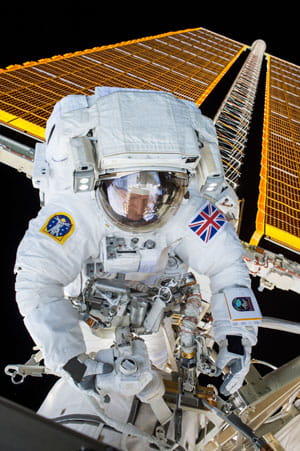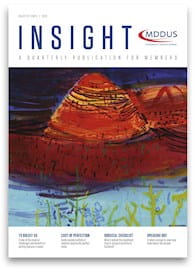
IT’S 50 YEARS since Apollo XI delivered Neil Armstrong and Buzz Aldrin onto the cratered surface of the moon, and the world’s most famous split infinitive “to boldly go” is as inspiring and relevant today as it was then – perhaps more so as space scientists pursue the dream of manned spaceflights to Mars.
But even as researchers conjure the out-ofthis-world technology needed to realise this dream, they must also continue to address what is possibly the weakest link in the 140-million-mile chain to Mars: the human body and its reliance on gravity. In space, oxygen can be supplied, just as on Earth, atmospheric pressure likewise, but a human without gravity is pretty much like a fish out of water.
In low or zero-gravity environments, vestibular feedback goes awry, with dizziness, headaches and instability. Muscles begin to waste away. Blood volume is reduced, as is the size of the heart which is not having to pump as hard. Changes in ocular pressure can affect eyesight. Bone density is badly hit – astronauts lose around one per cent of bone mass a month. They also tend to stretch, by as much as 6cm, without the normal compression of the intervertebral discs. Consequently, most suffer from low back pain and all are at risk of severe spinal injury for the first year post-mission.
MICROGRAVITY MITIGATION
With increasing distance and time in space, the challenges become greater. What will be the effects of years spent in low-gravity environments? How can these be mitigated?
These are among the questions scientists like Nick Caplan, a professor of aerospace medicine and rehabilitation at Northumbria University, are trying to answer. He’s been working on the problem of deconditioning of the body, particularly of the spine, among space travellers for 10 years.
He explains: "Under gravity, the muscles around the spine have to work continuously to keep it upright so you don’t collapse into a heap. In space, spinal muscles become weaker because you don’t need them to keep the spine upright. We’re looking at how to restore these muscles after space flights."
To this end, Caplan has investigated a rehabilitation device known as the Functional Re-adaptive Exercise Device (FRED) – a cross-trainer with a difference. Unlike those you’ll see in the local gym, FRED is not about cardiovascular fitness. "The muscles around the spine fire at low levels all the time. We’re not trying to fatigue the body to train them. We’re trying to promote their continuous activation."
He uses a combination of MRI and intramuscular electromyography to monitor spinal muscle structure and function, and changes under deconditioning and rehabilitation.
Because of the link between space travel and back pain – and because astronauts are extremely busy people – early work on FRED recruited a cohort with low back pain as surrogates. Now, Caplan and his team are getting ready to take part in a 60-day bedrest study supported by the European Space Agency (ESA). Participants will lie at an angle of 6° with their heads below their feet.
"Bedrest studies are seen as the most valid simulation of spaceflight if you want to look at long-term changes to the human body, in terms of the muscles, bones, cardiovascular system," he says. He’ll monitor the subjects before and immediately after the bedrest, and again after two-weeks’ training on FRED to see if this "kickstarts the muscle control pathways".
As part of the same experiment, a proportion of the participants will spend 30 minutes each day on a near-horizontal 'short-arm centrifuge'. The aim is to see whether mimicking gravity by spinning the participants at 30 rpm will help to reduce the deconditioning in the first place.
Another testbed is in actual rather than simulated microgravity. Caplan has also taken his research on board Novespace’s specially adapted Airbus. Jokingly referred to as the 'vomit comet', this plane flies in parabolic arcs, swinging between microgravity and 2g, double that of the Earth. The low-gravity effect is maintained for under a minute, during which measurements are taken. A single flight can include up to 30 parabolas. Caplan used 3D motion capture to track movement of the spine during the flights, and electromyography to measure muscle activity.
"We were able to look at how muscles in the spine changed in their function as gravity reduced from 1g to 0.25g, which is halfway between lunar and Mars gravity."
MARS REHEARSAL
As essential an issue as it is, space medics are responsible for more than mitigating the effects of low gravity. Research and planning focus on protecting humans from all adverse conditions in the space environment, including, for example, temperature variations of –150°C to +150°C on the moon’s surface.
As part of this effort, space agencies carry out 'analogue missions' on Earth that simulate space activity to the n-th degree.
Bonnie Posselt, a specialist registrar in aviation and space medicine and medical officer with the Austrian Space Forum, took part in one analogue mission in the desert in Oman, a practice run for a trip to Mars. There she monitored 'analogue astronauts' as they performed tasks on rock samples and the like in their sealed spacesuits.
She assessed all the different types of risk – general medical (cuts, rashes, headaches), environmental (heat), occupational (pressure sores and musculoskeletal issues from the suit) and, of course, real-life emergencies.
There was even a 20-minute communication delay to simulate the distance to Mars. "It was incredible, a really steep learning curve. The stuff I learnt there was phenomenal."
Posselt has since moved onto Wright- Patterson Air Force Base in the USA where she’s now working on helmet-mounted display systems for astronauts. The next generation are likely to be stereoscopic, giving a 3D image. It’s technology she can envisage being used on Earth one day.
Surgeons, for example, might use headmounted displays that map an anatomical picture to the patient on the operating table, identifying organs or vessels.
OTHER HEALTHCARE BENEFITS
A surgical display of this type is perhaps a long way away, but there are numerous examples of this beneficial ‘flip side’ of space age research already in use in healthcare.
For example, Nasa’s digital image processing techniques for enhancing pictures from the Moon have long been used in CT and MRI.
Their research with ultrasound has greatly expanded its diagnostic capability – including a lung ultrasound technique that diagnoses pneumothorax with higher accuracy than a chest X-ray – as well as its use among nonexperts in remote diagnosis and telemedicine.
Satellite applications derived from space tech are starting to find a role in remote monitoring and early diagnostics, as well as facilitating shared clinical-decision making. One project recently funded by the UK Space Agency, EARTH SCAN, will create a cloud-based AI system to support doctors in identifying polyps by analysing live colonoscopy video. It uses the same between Earth and spacecraft up to millions of miles away.
Another Space Agency-funded project, based on technology used to study stars in distant galaxies, aims to develop a portable 3D X-ray machine to spot early-stage cancers. The hope is that patients can be scanned in GPs’ surgeries, reducing the need for trips to hospital for busy X-ray and CT scanners.
And in one of the more unusual spinoffs, a hand-held probe using mass spectrometry technology originally devised to decipher the chemical make-up of comets looks set to revolutionise the search for hitherto impossible-to-find bedbugs in mattresses.
Nick Caplan sees a possible healthcare future for FRED too. "Astronauts or simulated astronauts provide an accelerated model of the ageing process. The deconditioning in space is very similar to what we see in an ageing population.
"If we can show that FRED works for them, then this is something we may be able to apply to healthcare patients."
Adam Campbell is a writer and editor in Edinburgh and regular contributor to MDDUS publications
PHOTOGRAPH: NASA
This page was correct at the time of publication. Any guidance is intended as general guidance for members only. If you are a member and need specific advice relating to your own circumstances, please contact one of our advisers.
Read more from this issue of Insight

Save this article
Save this article to a list of favourite articles which members can access in their account.
Save to library